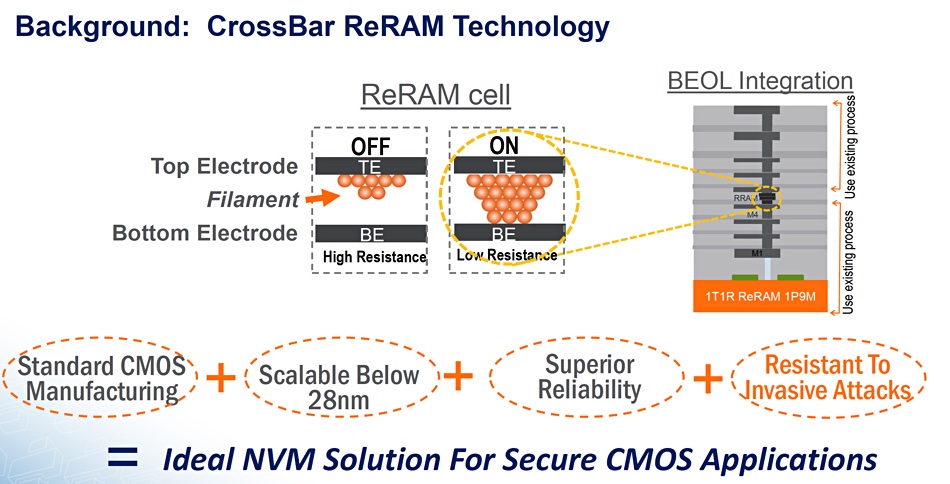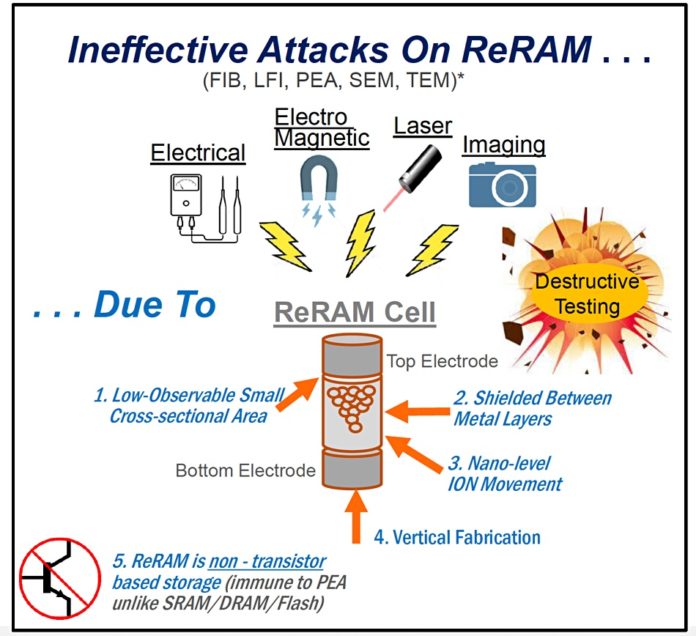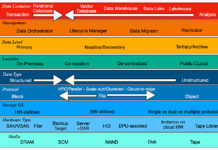ReRAM developer CrossBar is separating itself from other ReRAM pioneers by concentrating on the near invincibility of its chips against external content-detection threats.
Update; Weebit Nano funding rise and scaling targets added plus security comment; 26 April 2022.
Resistive RAM (ReRAM) is a fast non-volatile memory technology – storage-class memory relying on the formation of electrically conducting oxygen vacancy filaments through an otherwise insulating medium. This alters the resistance of the material between high and low states – the binary signalling mechanism. ReRAM is said to be as fast to read as SRAM (static random access memory), but lower cost with reduced power consumption and non-volatility. Weebit Nano and Intrinsic Technology are also developing ReRAM products. All three use a silicon oxide material and a crosspoint-style architecture.
Ashish Pancholy, CrossBar VP for marketing and sales, told us that CrossBar’s technology has “resistance to an extremely motivated and persistent attacker trying to sniff out memory contents.” This makes the product suited to storing highly sensitive information such as encryption keys. Pancholy believes CrossBar’s technology is ideal for secure CMOS applications as an embedded memory in standard CMOS manufacturing processes.

Starting last year, the company moved to focus more on secure memory and applications. It has found a niche in the hardware security field with Physically Unclonable Function (PUF) keys as a replacement for SRAM. PUF keys have a unique identifier or fingerprint, and Pancholy said an embedded hardware PUF dramatically reduces a device’s attack surface.
Pancholy enumerated the types of attack that technologically skilled hostiles might use to get at a memory device’s contents:
- Power analysis – Power use can vary with memory contents and so be used to infer the contents. ReRAM consumes little power and is resistant to simple/differential power analysis. Power is constant regardless of storage contents).
- Optics attack – ReRAM is secure against optics-based attack due to dense metal wiring. Resistant to delayering and backside attacks since ReRAM is implemented in middle layers.
- No transistor – ReRAM is non-transistor-based and immune to photon emission analysis, unlike SRAM, Flash, ROM, and floating Gate/anti-fuse OTP.
- Transmission Electron Microscopy (TEM) – Techniques such as TEM cannot effectively detect localized atomic-level defects.
- Electromagnetic analysis – High “cell” density limits the effectiveness of electromagnetic analysis (size of magnetic probe must be comparable to the target device size for accurate attack). It’s also easy to make physical magnetic shields to protect the ReRAM.
- Low-bit error rate (PUF) – Unlike conventional PUF (physically unclonable function) keys with high bit error rates, ReRAM PUF does not require helper data, which makes it more secure from invasive attacks.

We didn’t know that such attack methods existed, nor realize that attackers would go to such extreme lengths to get at the contents of digital devices. Pancholy said that the market for attack-resistant devices is growing with the IoT market.
A Weebit spokesperson offered the thought that the security features, such as immunity to attacks, etc., are really features that are inherent in ReRAM technology in general and not unique to Crossbar.
CrossBar background
CrossBar was founded in 2010 by chief scientist, professor Wei Lu, VP engineering Hagop Nazarian, and departed ex-CEOs Chris de Groat and George Minassian. The latter left in March 2002. Dr Ker Zhang, an entrepreneur-in-residence at lead investor Kleiner Perkins, and executive chairman since March 2019, then became CEO. CrossBar has taken in almost $131 million in funding across four VC rounds – the last in 2015 for $35 million – and three subsequent venture rounds, the most recent for $20.1 million in 2019. There are about 50 employees.
That makes it richly endowed compared to competitor Weebit Nano, which has raised $75 million since being founded in 2014, and ReRAM newcomer Intrinsic Technology, which was started up in 2017 and has raised just $1.8 million.
CrossBar has focused on patent-protecting its technology and has 301 filed patents worldwide with 193 issued in the US. Another 80-plus applications are pending elsewhere. Its revenue comes from licensing its patented technology to producers of CMOS chips embedding its ReRAM to provide fast, dense, non-volatile memory functionality.
It has developed 28nm foundry technology and is working on shrinking that to 12nm with Microsemi. Pancholy said there is potential for 10nm and possibly smaller technology – far below the limits of NAND. For comparison, Weebit and CEA-Lei have scaled down Weebit’s technology to 28nm and are targeting 22nm.
Intrinsic has demonstrated the scaling of its ReRAM technology down to 50nm.








